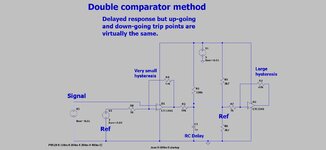cupoftea
Advanced Member level 5
Hi,
My sincere apologies, i meant to put this in the Analog Electronics section.
Do you agree that this “double comparator with delay” method is superior to just a single comparator with hysteresis?
The trouble with a “single comparator with hysteresis” is that the up-going and down-going trip points are too different. The double comparator method shown, allows up-going and down-going trip points to be pretty much the same.
There is some delay in the trip, but very often you do not care about this.
So why is this method not more used?
My sincere apologies, i meant to put this in the Analog Electronics section.
Do you agree that this “double comparator with delay” method is superior to just a single comparator with hysteresis?
The trouble with a “single comparator with hysteresis” is that the up-going and down-going trip points are too different. The double comparator method shown, allows up-going and down-going trip points to be pretty much the same.
There is some delay in the trip, but very often you do not care about this.
So why is this method not more used?
